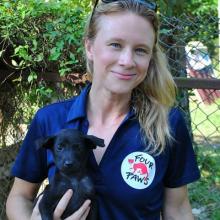This virtual exchange project is an old course with a new twist. The Topics in International Shelter Medicine will now be offered with a Virtual Exchange component. This new course will involve an interactive collaboration between enrolled students and international experts enrolled in the Virtual International Exchange for Animal Welfare course. By integrating these two course offerings, students will have a unique virtual opportunity to collaborate not only with each other, but also learn from and interact directly with those working in the field, all over the world. The course will consist of the traditional 9 module structure of the Topics in International Shelter Medicine, now with Virtual Exchange components included. Students with the course will collaborate with colleagues abroad to directly discuss animal welfare issues across cultural and geographic areas, and work together to develop innovative and practical solutions.
- Compare and contrast attitudes and practices towards companion animals across different cultures.
- Explore how to adopt and adapt solutions for animal welfare issues across geographic and cultural divides.
- View the content of online graduate courses in action with students from other countries and cultures.
Student-to-Student Project
Virtual Guest Speaker
Asynchronous Activities: 10 hours
Local group activities: 5 hours
Individual work: 16 hours
Messaging Applications (WhatsApp)
Learning Management Systems (Canvas)
Collaborative Authoring Platforms (Google Drive)
Message Boards/ Video Boards (Flipgrid/Padlet)
- Module 1: Introduction- Indroduction, syllabus, introduction to dog population management
- Module 2: An introduction to dog population management- History and context
- Module 3: International sheltering- Challenges of operating shelters in resource limited environments
- Module 4: Shelter medicine in Europe, Asia, and Australia- Comparison of cat adoption policies
- Module 5: Dog and cat meat trade- Threats to public health and animal welfare
- Module 6: Medical practices in resource-limited environments- Practical and cost-effective diagnostic and treatment strategist for commonly observed conditions in cats and dogs
- Module 7: Operating a field spay/neuter clinic- Selecting a clinic site, patient return to-the-field, instrument sterilization, anesthetic protocols, ovariohysterectomy, identification of sterilized animals
- Module 8: Programmatic M&E- Programmatic strategic planning and assessment
- Module 9: Wrap-up- International opportunities, methods of evaluating potential programs


